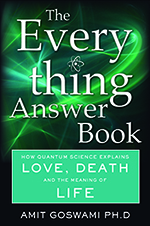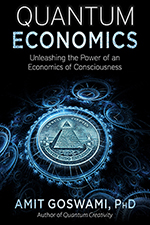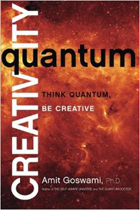Archetypal Dichotomies: Good and Evil
According to anthropologists, we can discern four eras of human mental development: the hunter-gatherer era when the mind gave meaning to the physical–the era of the physical mind; the garden agriculture era when the mind gave meaning to vital feelings—the era of the vital mind; the rational/mental current era when the mind gives meaning to thinking itself—rational mind; and a future era of the intuitive mind when the mind will give meaning to our intuitions.
The effort of our ancestors of the vital mind era on making representations of the Platonic archetypes in general gave us the Jungian archetypes of the so-called collective unconscious, and they are often split in dichotomies. In this way, via the collective unconscious, we also experience dichotomy in other archetypal areas of our lives (the exception is wholeness). Not understanding how to manage these archetypal dichotomies also creates inner conflict.
A particularly troublesome dichotomy is that of good versus evil: We have both a “dark side” as well as a “light side” to our personality, a sort of Mr. Hyde and Dr. Jekyll in Freudian terms. This is why seemingly good people sometimes do bad things.
Religions introduce the concept of morality as the solution of the good-evil dichotomy: Be good because it is the moral thing to do. But of course, given the Jungian split in the collective unconscious and our negative emotional brain circuits, we cannot be good just by wishing it. We have to study the archetype of goodness creatively and directly discover the truth of ethics and morality. In this way, via creativity, we can override built-in software of negative emotions that the collective unconscious represents.
And if our educational system encourages you to check out ethics via your own creativity, even going through the preparation stage, you will be better for it. For it is a fact, that when eventually you take a quantum leap to the truth of ethics, the goodness circuit of positive emotion that you build in your brain will be quite adequate to overrule your evolutionarily inherited negativity, evil, although it may take a while. This is what the exploration of the archetype of wholeness prompts us to do.
Other Archetypal Dichotomies
Here is another way in which we experience archetypal dichotomy: the true-false dichotomy. In Platonic terms, truth is absolute; that which is false is simply ignorance of truth. But because of the true-false dichotomy of our collective unconscious, we tend to give “false” a lot more importance than it deserves. The news media, for example, sometimes become obsessed to maintain balance between true and false news instead of just emphasizing the truth. Or worse, you get Fox News, an entire network of mostly false news.
We are naturally designed with potentiality to be authentic and truthful in our behavior, but we are evolutionarily and socially programmed to ignore this potentiality. Instead we are encouraged to be a certain way in order to fit in with society, to take on different personalities to fit different situations. This creates the culture of political correctness and backlash.
Another dichotomy of the collective unconscious is the one between purity and sin, which may indirectly contribute to racist ideology. In our collective unconscious, black stands for the negative or undesirable. Magic with negative intent is called black magic. In India, they separate white and dark traditions of spirituality; the dark tradition follows exploration of evil (stuff like sex, ugh!).
To arrive at wholeness, we need to integrate all these dichotomies as well.
Balancing the archetypal dichotomies consists eventually of exploring all the different major archetypes and bringing them down from potentiality to manifestation.
Is integrating these dichotomies worth it?” The great Swami Vivekananda used to boast about his guru Ramakrishna, “My guru has the most beautiful eyes.” His challengers would say, “You are biased. His eyes are just like ordinary eyes.” And Vivekananda would smirk, “Where we see ugly and beauty, my guru only sees beauty. That’s why he has the most beautiful eyes that do not discern between such dichotomies.”
Indeed, Ramakrishna treated everyone the same, rich and poor, untouchables and high caste, prostitutes and Brahmins. Isn’t that worth it?
The Archetype of Wholeness
The archetype of wholeness is commonly the objective of exploration of the profession of health and healing—mental and physical—at least to a minimal extent. A patient is sick when his or her organs are not working in balance and harmony, although an allopathic physician today would perhaps not see it that way. In contrast from a quantum worldview perspective, for true health, not only the physical but all the five “bodies” of a human being—physical, vital (the source of the experience of feeling), mental, supra-mental or archetypal, and bliss (the unity)—need to be in balance and harmony.
Like other professions, the healing profession also makes it difficult for anyone to explore the archetype of wholeness, and it would take quantum activism and a full-fledged paradigm shift to quantum integrative medicine to change things. Fortunately, this is under way.
The point though is that the archetype of wholeness is much more than restoring physical health or even restoring mental health in the way that we ordinarily understand it. In my recent book written with psychotherapist Sunita Pattani, The Quantum Science of Happiness, we have developed a scale of happiness ranging from 0 to 6; 0 for psychopathology and 6 for the traditional self-realized, God-realized enlightened people. On this scale, the realization and embodiment of the archetype of wholeness counts as happiness level 5, which puts it just a notch below classic enlightenment. I call this level quantum enlightenment.
However, there is another factor than happiness. Yes, all people seek happiness, no doubt. But to live in the world, one not only needs happiness but also skillful action or intelligence. Intelligence to deal with any stimulus with optimal response, which is what skill is about. Artificial intelligence is good in informational and mechanical intelligence, and that defines their scope. For human beings, this robotic intelligence makes you a human only marginally, even if you excel in it. Mental intelligence—the ability of meaning processing—is next and there are multiple sheds of mental intelligence depending on the various archetypes—implicit or explicit—each requiring its own brand of intelligence. Next come feelings. When we integrate mental thinking and vital feeling in the exploration of the world, especially relationships, we get emotional intelligence. When we dedicate our lives to the archetypal explorations within the overall archetype of wholeness (leaving out only the archetype of self), we get supra-mental intelligence.
In this way quantum enlightenment is the ability to act with the highest intelligence available to humans—supra-mental intelligence, a complete mastery over skillful action.



